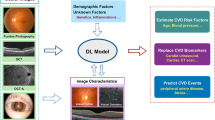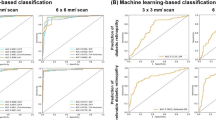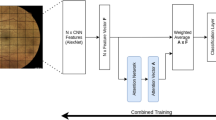Abstract
Background/Objectives
Optical coherence tomography angiography (OCTA) has been found to identify changes in the retinal microvasculature of people with various cardiometabolic factors. Machine learning has previously been applied within ophthalmic imaging but has not yet been applied to these risk factors. The study aims to assess the feasibility of predicting the presence or absence of cardiovascular conditions and their associated risk factors using machine learning and OCTA.
Methods
Cross-sectional study. Demographic and co-morbidity data was collected for each participant undergoing 3 × 3 mm, 6 × 6 mm and 8 × 8 mm OCTA scanning using the Carl Zeiss CIRRUS HD-OCT model 5000. The data was then pre-processed and randomly split into training and testing datasets (75%/25% split) before being applied to two models (Convolutional Neural Network and MoblieNetV2). Once developed on the training dataset, their performance was assessed on the unseen test dataset.
Results
Two hundred forty-seven participants were included. Both models performed best in predicting the presence of hyperlipidaemia in 3 × 3 mm scans with an AUC of 0.74 and 0.81, and accuracy of 0.79 for CNN and MobileNetV2 respectively. Modest performance was achieved in the identification of diabetes mellitus, hypertension and congestive heart failure in 3 × 3 mm scans (all with AUC and accuracy >0.5). There was no significant recognition for 6 × 6 and 8 × 8 mm for any cardiometabolic risk factor.
Conclusion
This study demonstrates the strength of ML to identify the presence cardiometabolic factors, in particular hyperlipidaemia, in high-resolution 3 × 3 mm OCTA scans. Early detection of risk factors prior to a clinically significant event, will assist in preventing adverse outcomes for people.
This is a preview of subscription content, access via your institution
Access options
Subscribe to this journal
Receive 18 print issues and online access
$259.00 per year
only $14.39 per issue
Buy this article
- Purchase on Springer Link
- Instant access to full article PDF
Prices may be subject to local taxes which are calculated during checkout

Similar content being viewed by others
Data availability
The data that support the findings of this study are not openly available due to reasons of sensitivity. They are available from the corresponding author upon reasonable request.
References
Arnould L, Guenancia C, Azemar A, Alan G, Pitois S, Bichat F, et al. The EYE-MI pilot study: a prospective acute coronary syndrome cohort evaluated with retinal optical coherence tomography angiography. Investig Ophthalmol Vis Sci. 2018;59:4299–306.
Chua J, Chin CWL, Hong J, Chee ML, Le TT, Ting DSW, et al. Impact of hypertension on retinal capillary microvasculature using optical coherence tomographic angiography. J Hypertens. 2019;37:572–80.
Lim HB, Lee MW, Park JH, Kim K, Jo YJ, Kim JY. Changes in ganglion cell-inner plexiform layer thickness and retinal microvasculature in hypertension: an optical coherence tomography angiography study. Am J Ophthalmol. 2019;199:167–76.
Yeung L, Wu IW, Sun CC, Liu CF, Chen SY, Tseng CH, et al. Early retinal microvascular abnormalities in patients with chronic kidney disease. Microcirculation. 2019;26:e12555.
Cao D, Yang D, Huang Z, Zeng Y, Wang J, Hu Y, et al. Optical coherence tomography angiography discerns preclinical diabetic retinopathy in eyes of patients with type 2 diabetes without clinical diabetic retinopathy. Acta Diabetol. 2018;55:469–77.
Ciesielski M, Rakowicz P, Stopa M. Immediate effects of smoking on optic nerve and macular perfusion measured by optical coherence tomography angiography. Sci Rep. 2019;9:10161.
Ayhan Z, Kaya M, Ozturk T, Karti O, Hakan, Oner F. Evaluation of macular perfusion in healthy smokers by using optical coherence tomography angiography. Ophthalmic Surg Lasers Imaging Retin. 2017;48:617–22.
Sun MT, Huang S, Chan W, Craig JE, Knight LSW, Sanders P, et al. Impact of cardiometabolic factors on retinal vasculature: A 3 × 3, 6 × 6 and 8 × 8-mm ocular coherence tomography angiography study. Clin Exp Ophthalmol. 2021;49:260–9.
Karekar SR, Vazifdar AK. Current status of clinical research using artificial intelligence techniques :a registry-based audit. Perspect Clin Res. 2021;12:48–52.
Li M, Yang Y, Jiang H, Gregori G, Roisman L, Zheng F, et al. Retinal microvascular network and microcirculation assessments in high myopia. Am J Ophthalmol. 2017;174:56–67.
Spaide RF, Fujimoto JG, Waheed NK. Image artifacts in optical coherence tomography angiography. Retina. 2015;35:2163–80.
Sandler M, Howard A, Zhu M, Zhmoginov A, Chen L. MobileNetV2: inverted residuals and linear bottlenecks. 2019. https://arxiv.org/abs/1801.04381.
Youden WJ. Index for rating diagnostic tests. Cancer. 1950;3:32–35.
Hormel TT, Hwang TS, Bailey ST, Wilson DJ, Huang D, Jia Y. Artificial intelligence in OCT angiography. Prog Retin Eye Res. 2021;85:100965.
Lauermann JL, Treder M, Alnawaiseh M, Clemens CR, Eter N, Alten F. Automated OCT angiography image quality assessment using a deep learning algorithm. Graefes Arch Clin Exp Ophthalmol. 2019;257:1641–8.
Aslam TM, Hoyle DC, Puri V, Bento G. Differentiation of diabetic status using statistical and machine learning techniques on optical coherence tomography angiography images. Transl Vis Sci Technol. 2020;9:2.
Sandhu HS, Elmogy M, Taher Sharafeldeen A, Elsharkawy M, El-Adawy N, Eltanboly A, et al. Automated diagnosis of diabetic retinopathy using clinical biomarkers, optical coherence tomography, and optical coherence tomography angiography. Am J Ophthalmol. 2020;216:201–6.
Wang J, Hormel TT, Gao L, Zang P, Guo Y, Wang X, et al. Automated diagnosis and segmentation of choroidal neovascularization in OCT angiography using deep learning. Biomed Opt Express. 2020;11:927–44.
Le D, Alam M, Yao CK, Lim JI, Hsieh YT, Chan RVP, et al. Transfer learning for automated OCTA detection of diabetic retinopathy. Transl Vis Sci Technol. 2020;9:35.
Heisler M, Karst S, Lo J, Mammo Z, Yu T, Warner S, et al. Ensemble deep learning for diabetic retinopathy detection using optical coherence tomography angiography. Transl Vis Sci Technol. 2020;9:20.
Mehta N, Braun PX, Gendelman I, Alibhai AY, Arya M, Duker JS, et al. Repeatability of binarization thresholding methods for optical coherence tomography angiography image quantification. Sci Rep. 2020;10:15368.
Author information
Authors and Affiliations
Contributions
SH, SB, WC, CXW, MTS were all responsible for data collection, designing the study, analysing results, creation of tables, drafting of the study and review of the final manuscript. DS and CM were responsible for result interpretation and review of the final manuscript.
Corresponding author
Ethics declarations
Competing interests
The authors declare no competing interests.
Additional information
Publisher’s note Springer Nature remains neutral with regard to jurisdictional claims in published maps and institutional affiliations.
Rights and permissions
Springer Nature or its licensor (e.g. a society or other partner) holds exclusive rights to this article under a publishing agreement with the author(s) or other rightsholder(s); author self-archiving of the accepted manuscript version of this article is solely governed by the terms of such publishing agreement and applicable law.
About this article
Cite this article
Huang, S., Bacchi, S., Chan, W. et al. Detection of systemic cardiovascular illnesses and cardiometabolic risk factors with machine learning and optical coherence tomography angiography: a pilot study. Eye 37, 3629–3633 (2023). https://doi.org/10.1038/s41433-023-02570-4
Received:
Revised:
Accepted:
Published:
Issue Date:
DOI: https://doi.org/10.1038/s41433-023-02570-4



